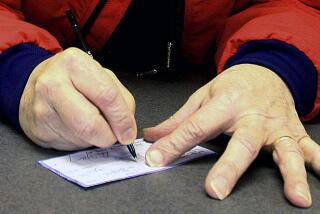Most ATM Fraud the Work of Thieves--Not High-Tech Wizards
- Share via
The proliferation of automated teller machines has led to a rise in ATM fraud. But rather than spawning a new breed of high-tech computer criminals, most cases involve the theft of access cards.
To be sure, there have been some big losses. But they usually turn out to be inside jobs.
In Los Angeles last year, Security Pacific National Bank lost $350,000 in an unsolved ATM fraud that federal authorities suspect involved a bank employee. In another case, a ring of would-be ATM bandits was broken up before executing a scheme that authorities said could have netted $14 million from accounts at Bank of America. The leader was a computer programmer working on ATMs.
But more than 95% of ATM fraud cases come from unauthorized use of cards or other direct consumer fraud, according to a survey last year by the Bank Administration Institute, an industry research group.
And while losses in individual cases of lost or stolen cards are usually small, they have led to enough complaints from consumers that federal regulators have set up guidelines limiting customer liability.
“From the banks’ perspective, the regulations are very protective of the consumer,” said Marcia Z. Sullivan, a lawyer for the Consumer Bankers Assn. in Washington. “Even if the consumer is negligent and leaves his or her PIN (personal identification number) on the card, there is no way that the consumer’s negligence contributes to whether or not they get their money back.”
The consumer’s liability is determined by the promptness in reporting the loss of the card or the unauthorized transfers.
Lie Detectors Used
Under the rules, a consumer can limit his or her liability to $50 by notifying the bank of the loss or theft within two business days. A customer who waits more than two days may be liable for up to $500. Waiting more than 60 days leaves a customer responsible for any amount withdrawn.
Liability for unauthorized withdrawals can lead to disputes between customers and banks. Often banks find that family members have made the unauthorized withdrawals. Some banks use lie detectors to verify customer stories.
Consumers who are not satisfied with an institution’s response may complain to the consumer division of the agency overseeing the institution. For banks, that is either the Federal Deposit Insurance Corp., Federal Reserve Board or the Office of the U.S. Comptroller of the Currency. For savings and loan firms, it is the Federal Home Loan Bank Board.
Banks and ATM networks advise several steps for minimizing the chances of a loss:
Memorize your PIN. Do not write it down, particularly not on the back of your card or elsewhere in your wallet or purse.
Protect your ATM access card as carefully as cash and credit cards. If it is lost or stolen, notify your bank or thrift immediately.
Avoid allowing anyone watch you enter the PIN in the machine. Use your body or hand to shield the keyboard.
Be aware of your surroundings when you use an ATM. Avoid using machines in unlighted locations or isolated spots at night.
More to Read
Inside the business of entertainment
The Wide Shot brings you news, analysis and insights on everything from streaming wars to production — and what it all means for the future.
You may occasionally receive promotional content from the Los Angeles Times.










